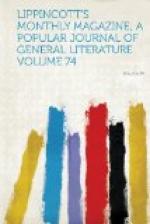As by the Templars’
hold you go,
The
horse and lamb displayed
In emblematic
figures show
The
merits of their trade.
The clients may
infer from thence
How
just is their profession:
The lamb sets
forth their innocence,
The
horse their expedition.
O happy Britons,
happy isle,
Let
foreign nations say,
Where you get
justice without guile,
And
law without delay!
In answer and in ridicule of which, a second scribbler penned the following stanzas beneath:
Deluded men, these
holds forego,
Nor
trust such cunning elves:
These artful emblems
tend to show
Their
clients, not themselves.
’Tis all
a trick; these are all shams
By
which they mean to cheat you:
But have a care,—for
you’re the lambs,
And
they the wolves that eat you.
Nor let the thought
of “no delay”
To
these their courts misguide you:
’Tis you’re
the showy horse, and they
The
jockeys that will ride you.]
The din and devastation of civil strife and the smoke and flame of conflagration have more than once surged high and furious in and around the Temple. In Wat Tyler’s rebellion many of the houses were razed by the rioters, books and parchments were carried away and fed to bonfires, and it was the intention of the rebels to destroy the precinct and the lawyers together, for thus, they said, they would obliterate both unjust laws and corrupt law-makers. The “No-Popery” rioters in 1780 marched to attack the Temple, but were awed into flight by the apparently determined front presented by the lawyers and students, who were really in desperate fear themselves. Street-fights with the lawless Alsatians of the adjoining Whitefriars region were at one time frequent.[B] In 1553, and again in 1669, the mayor of the city essayed to “pass through the cloisters with drawn sword.” The Temple claimed immunity from civic control, and on both occasions the mayor’s weapon was beaten down and a bloody affray resulted. An appeal growing out of this event was made to Charles II. by Heneage Finch in behalf of the Temple, but the question is still unsettled. Hence the modern Templars close their gates at ten o’clock every night, and when the “charity children” of the adjacent parishes “beat the bounds” on Ascension Day, redouble their vigilance. The rich rental of the property pays no local taxes, though repeated efforts have been made to assess it.
[Footnote B: Salisbury Court, Whitefriars, enjoyed for centuries the privilege of a sanctuary—at first for criminals, but finally for debtors only—until 1697, when it was abolished by royal warrant. It was nicknamed “Alsatia,” in imitation of the frontier province of the same name, which was long a cause of contention and familiarly known to English soldiers in the long Continental wars. As Cunningham observes, “In the Temple students were trying to keep the law, and in Alsatia, adjoining, debtors to avoid and violate it. The Alsatians were troublesome neighbors to the Templars, and the Templars as troublesome neighbors to the Alsatians.”]




